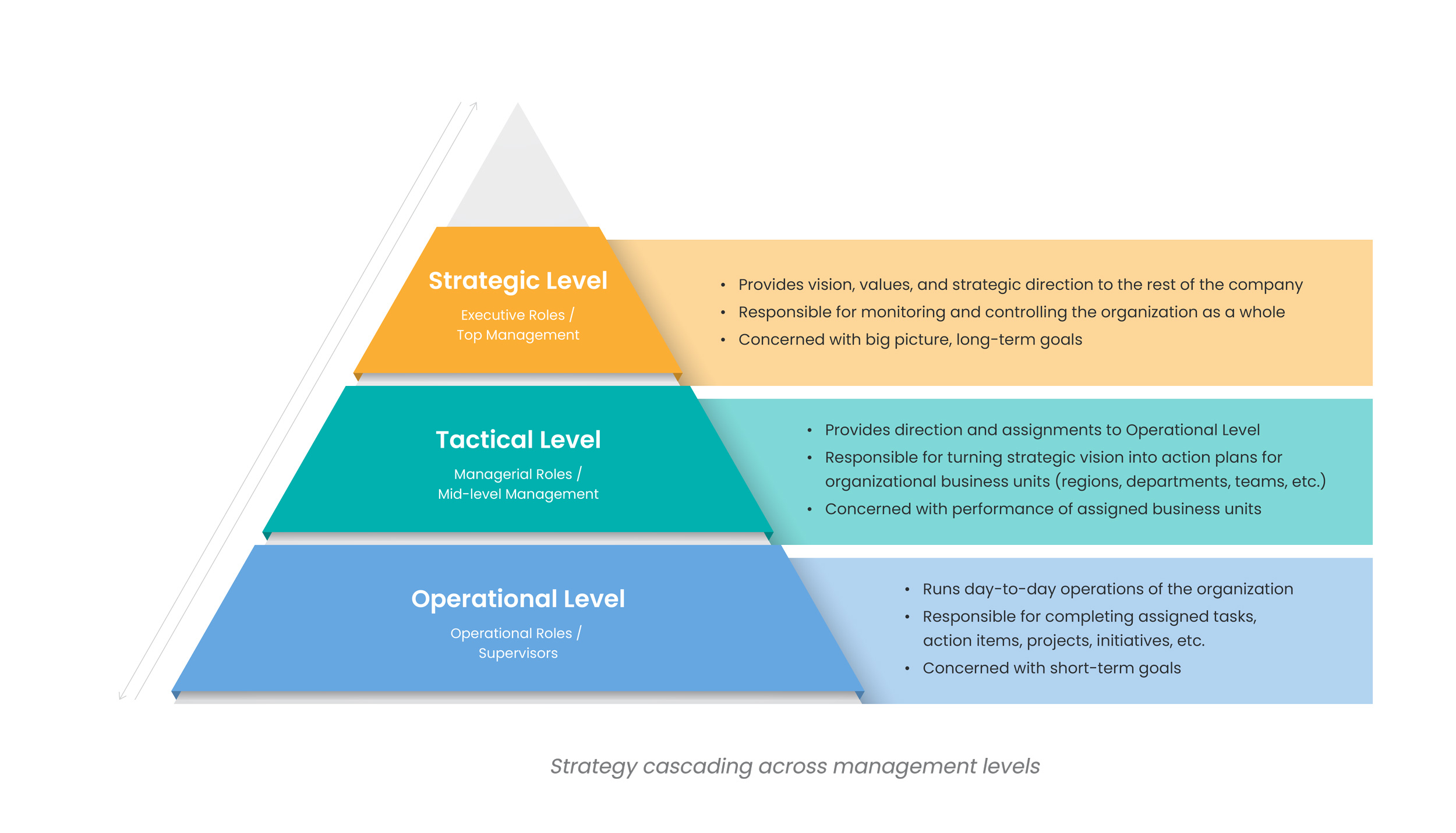Introduction
How to overcome common pitfalls of strategy execution and turn your strategy into action? Every year numerous organizations attempt to implement a new corporate strategy in an effort to yield positive changes in their organization. And, as you may have guessed, many of them fail. The commonly stated reason for that is a poor strategy execution. In fact, according to Fortune magazine report, 9 out of 10 business strategies fail due to poor execution.1
Why is that? Why do organizations fail to execute their strategy after what is often months of hard work to create it? To answer simply, strategy execution is a challenging task. Anyone who has ever attempted to execute a strategy knows this firsthand. Even if your organization managed to come up with a clearly defined strategy on paper, executing that strategy in practice is a whole another endeavor. One that requires alignment, collective effort, persistence, engagement, and lots of focused action.
How can you ensure a successful strategy execution at your organization? Consider the tips below.
But first, let’s cover the basics.
What is strategy?
Simply put, strategy is the process of defining where you are now, where you want to go, and how you plan to get there, and then setting your plans into action and tracking their progress against your set objectives. A solid corporate strategy considers a large number of factors including the organization’s business environment, market conditions, competitors, as well as structures, employees, products, processes, risks, long-term and short-term goals, and so on.
Why is strategy important?
Having a strategy is important because it provides a direction for the entire organization. A clearly defined strategy serves as a blueprint to all your stakeholders for what your organization’s goals are and what steps you expect your stakeholders to take to reach those goals. Without a strategy, it may be difficult for your organization to be in alignment and make the right decisions because your stakeholders won’t understand what you are trying to achieve.
What is strategy execution?
Strategy execution is the process of setting your strategic plans into action in an effort to reach your organization’s goals and objectives. It is the process that comes after strategic planning where you define your strategic plans.
Why do strategies fail?
According to Harvard Business Review, 67% of well-formulated strategies fail due to poor execution.2 But there are other reasons too. Some of the common obstacles to successful strategy execution are:
- A vague strategy / a lack of understanding the strategy
- Lack of communication of responsibility for decisions
- Lack of feelings of ownership of strategic plans or steps
- Lack of adequate resources
- Burnout and loss of motivation
- Lack of long-term focus and engagement
- Lack of information sharing among individuals and business units responsible for strategy execution
How to combat these pitfalls can be summarized as a set of practical tips outlined below. While simply following the tips does not guarantee a strategy execution success, it will greatly improve the odds.
7 Tips for successful strategy execution
1. Start with a clearly defined strategy
As we defined earlier, strategy is the process of defining where you are now, where you want to be, and how you plan to get there, and then setting your plans into action and tracking their progress against your set objectives. To develop a strategy for your organization, a good place to start is by assessing your organization’s customer value proposition (CVP), i.e., What value do you bring to your customers? Who are your customers? What are the benefits of your product or service? How are you different from your competition?
Based on your self-assessment, define your vision and objectives. Articulate where your organization is now (your current state), where you are headed (your strategic destination), and how you plan to get there (your plans).
Ensure to involve key decision makers from all three management levels of your organization – strategic, tactical, and operational. Involving those who will eventually be responsible for executing various parts of your strategy helps foster stakeholder engagement early on and leads to higher a commitment to the plans when it is time to execute them.
Your executive team (Strategic Level) should provide strategic direction to your management teams (Tactical Level) so that they could create corresponding plans and pass them onto appropriate operational teams (Operational Level) for execution.

To make your strategy clearly defined, describe it in a way that is easy to understand – using common language and agreed-upon terminology. (If your employees don’t understand your strategy or if they find it confusing, they won’t be able to execute it.) Clarify your high-level goals into actionable project goals. Be specific about who or which team is responsible for executing each plan, task, or initiative, and what the due dates are. Clarity drives efficient and effective business processes.
Pro Tip: When crafting your strategy, don’t underestimate the input from your operational level employees. They are the closest to your customers, and therefore can provide valuable insights into your customers’ needs, wants, challenges, behaviors, and so on. You never know where the best ideas will come from.
2. Communicate your strategy
To execute your strategy, you must communicate it. For your strategy execution to be a success, employees across all levels of your organization will need to understand what your strategy is, how it affects them and their role, and what they are required to do. If no one communicates to your teams what they are expected to do, you can’t expect them to do it.
Communication is important not only at the beginning of your strategy execution but throughout the entire process from planning to executing and monitoring your strategy. Especially if you are introducing a new strategy, you cannot overcommunicate it.
To effectively communicate strategy throughout your organization, ensure to have good lines of top-down and bottom-up communication set up.
- Top-down communication (communication from the strategic level down to the tactical and operational levels) enables senior management to communicate vision, instructions, news, updates, and other information to the front-line employees. Using top-down communication helps employees stay informed about the organization’s plans, goals, and objectives.
- Bottom-up communication (communication from the operational level up to the tactical and strategic levels) enables employees to provide feedback (e.g., learnings, ideas, thoughts, opinions, concerns, challenges, etc.) to senior management. Using bottom-up communications enables senior management to gain valuable insights from their front-line employees and optimize the organization’s strategy accordingly.
By using top-down and bottom-up lines of communication your organization can create a positive work environment, foster a culture of trust and mutual respect, and keep everyone connected to your organization’s strategy.
Pro Tip: Make no assumption that strategy communication happens automatically. Instead, make a point to include it as an action item in your plans. This will create clarity about who is responsible for ensuring that your strategy gets communicated.
3. Make your plans actionable
As Peter Drucker wrote,
“Plans are just good intentions unless they immediately degenerate into hard work.”
For your strategy execution to be successful, your plans must be actionable. To make your plans actionable, be specific about responsibilities, deadlines, and success metrics. Your plans should outline all steps that need to be taken to achieve each plan’s end goal. And each step should have an assigned owner and an agreed deadline. Deadlines drive action. If your plan involves ongoing initiatives with unspecified due dates, you should clearly define how and how often you will measure their success.
Pro Tip: Keep your plans agile and flexible. With today’s rapidly changing business environment, agile strategy execution is more important than ever. If your objectives suddenly change, you should be able to adjust your plans accordingly. If your plans are no longer aligned with your strategic objectives, you should be able to change them.
4. Assess your resources and capabilities
One of the common obstacles that companies face during strategy execution is the lack of adequate resources. This typically happens when trying to execute a strategy without first assessing the organization’s workforce and skillsets.
To overcome this obstacle, take a look at your current pool of resources and their capabilities. Then assign individual resources to the tasks and plans needed to execute your strategy. (Be certain that your assigned resources have the know-how for what you need them to do. Otherwise, you may need to facilitate training.)
Pro Tip: Don’t wait until the last minute to conduct the resources assessment. The best practice is to start assessing your staff as you are developing your strategy. The sooner you know where the gaps are, the sooner you can correct them.
By doing an assessment of your workforce and their skills against your strategy, you should be able to tell fairly quickly whether you are properly staffed, or whether you need to obtain additional competence.
Pro Tip: Don’t let a lack of qualified resources discourage you from pursuing your strategy. Instead, adjust your business resources to align with your strategy. As an organization you have the power to train, hire, buy, outsource, and acquire whatever resources and services you need. If your strategy requires a specific expertise – hire an expert. If your strategy requires extra capital – raise capital. Don’t ever say “We don’t have a budget for that.” If your organization values strategy as the cornerstone of success, it will support you with capital. And with capital, you can do almost anything.
5. Set the right timing expectations
Strategy execution is not a project. It is an ongoing, everlasting process. Depending on the scale of your strategic plans and initiatives, it may take weeks, months, or even years before you see a sign of desired outcomes. It is important to communicate these facts to your key stakeholders upfront to disarm the “When are we going to see results?” question, and to keep them motivated in a long run. Too often is strategy execution declared a failed project and abandoned before it is given a proper chance to succeed.
6. Keep your stakeholders informed and engaged
With your strategic plans and initiatives underway, ensure to keep your stakeholders informed about the progress towards your goals. This can be achieved through periodic reporting, scheduled discussions, or review meetings. To keep your front-line stakeholders engaged and motivated, consider rewarding them for good performance.
7. Get the right tool
As Sir Winston Churchill said,
“However beautiful the strategy, you should occasionally look at the results.”
Having a good strategy management software makes managing your strategy easy. With a good strategy management software, you can communicate your strategy across all levels of your organization and keep everyone informed about how you are progressing towards meeting your objectives. You may visualize your objectives on strategy maps, assign roles and responsibilities, track the progress of your plans and initiatives, follow up on past due tasks, automate alerts and notifications, generate high-level overview reports for senior management, and more.
Conclusion
Strategy execution is a challenging task for many reasons. According to Harvard Business Review, 67% of well-formulated strategies fail due to poor execution. Other reasons include unclear strategy, poorly defined roles and responsibilities, lack of ownership, lack of resources, loss of focus, lack of information sharing, and others.
To overcome these common pitfalls and turn your strategy into action, consider these 7 tips:
- Start with a clearly defined strategy – Define where you are now, where you want to be, and how you plan to get there.
- Communicate your strategy – To execute your strategy, you must communicate it.
- Make your plans actionable – Be specific about responsibilities, deadlines, and success metrics.
- Assess your resources and capabilities – No strategy can be executed unless you are properly staffed to do so.
- Set the right timing expectations – Strategy execution does not happen overnight.
- Keep your stakeholders informed and engaged – Regular meetings help keep strategy at the forefront of everyone’s mind.
- Get the right tool – Strategy Management is easier with the right software.
Successful strategy execution requires more than a clear direction from top management, it requires engagement and alignment across all organizational levels, and a collective effort of multiple business units each working on their assigned tasks, but all together working towards shared company objectives. With the right Strategy Management tool, organizations are able to better communicate their strategy across their organization, set their plans into action, monitor the status and progress of their initiatives, and ensure that their organization stays on track to meet its strategic objectives.

How to overcome common pitfalls of strategy execution and turn your strategy into action


